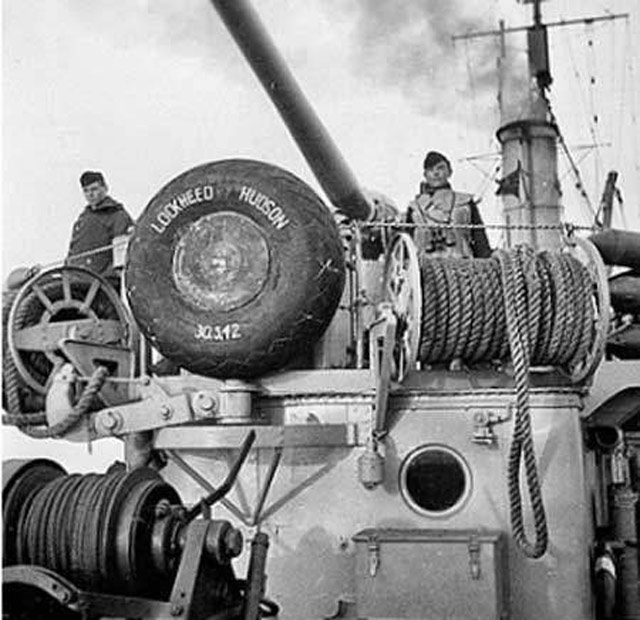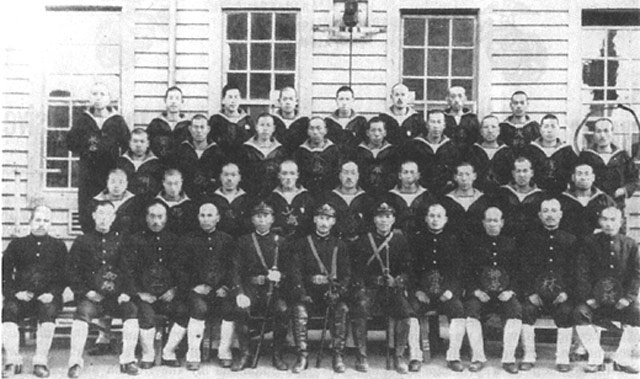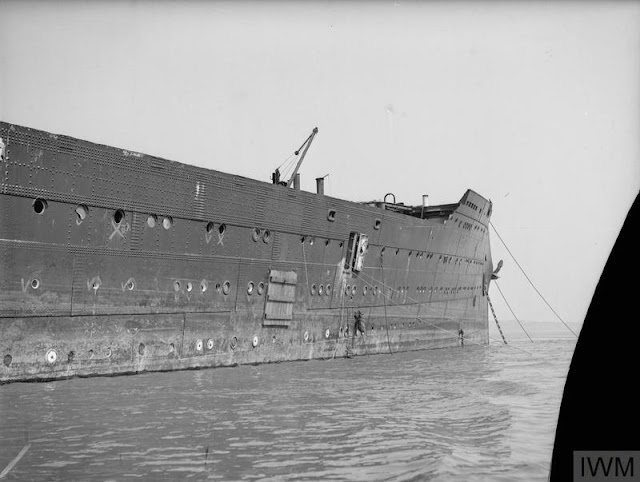Saturday 30 May 1942
 |
| Cologne Cathedral illuminated during Operation Millenium, 30-31 May 1942. |
Battle of the Pacific: Having spent 72 hours in drydock, during which its flight deck was patched and whole sections of internal frame were replaced, USS Yorktown (Task Force 17) departs Pearl Harbor on 30 May 1942 to join Enterprise and Hornet near Midway Island. Repairmen from repair ship Vestal, damaged on 7 December 1941, remain on the ship and continue to work as it sails. Yorktown's depleted air group is replenished with units from aircraft carrier Saratoga, which is under repair in San Diego. The carriers plan to rendezvous northeast of Midway.
Admiral Nimitz, meanwhile, has not forgotten about Saratoga. Today, he orders Captain Ramsey to sail from San Diego as soon as possible even if not 100% ready for action. The 7th Air Force dispatches six B-17 bombers from Hawaii to Midway to reinforce the 15 already there.
The Japanese invasion fleet bound for Midway already is at sea. Today, a task force of two light aircraft carriers and two troop transport ships departs from northern Honshu for the Aleutian Islands part of the plan.
The US 11th Air Force based in Alaska brings a new airfield at Umnak, Aleutian Islands, into operation with B-26 bombers of the 77th Bombardment Squadron (Medium).
Japanese patrol planes approach the French Frigate Shoals, but they spot two US Navy ships anchored there and are forced to turn back. Their mission was to rendezvous with a submarine there, refuel, and fly reconnaissance over Pearl Harbor. This is now impossible and the Japanese do not find out with certainty that the US Navy carriers have left. The US ships are stationed at the shoals because they know the Japanese have used them in the past as transit points for bombing missions against Hawaii.
US Navy submarine Pompano (SS-181) torpedoes and sinks Japanese troop transport Atsuta Maru in the East China Sea east of Okinawa. There are 39 crew and 37 passengers killed. Pompano escapes a depth charge attack by the transport's destroyer escort.
 |
| Pix magazine, 30 May 1942. |
Battle of the Indian Ocean: Two Japanese submarines (I-16 and I-20) stationed about ten miles off Diego Suarez, Madagascar, launch mini-subs to penetrate the harbor. Both subs make it into the harbor, which the British have left unguarded despite having spotted a Japanese floatplane on the 29th. At 17:10, the I-20 mini-sub M-20b (Lt. Akieda Saburo) launches a torpedo that hits Royal Navy battleship HMS Ramillies. The torpedo blows a 30x30 foot hole in the port bulge forward of "A" turret. This cuts off the entire ship's electrical system and floods the forward magazines and shell rooms.
Saburo is not done yet. He and the other sub remain in the harbor and, at 21:20, Saburo fires his second and last torpedo, which sinks 6,993-ton tanker British Loyalty in 65 feet of water (later raised and used as a hulk at Addu Atoll, Maldives). The subs remain in the harbor until the 31st.
B-17 bombers of the 10th Air Force again bomb the airfield at Myitkyina, Burma. This is the last attack against this target for the time being.
Eastern Front: The final, weak Soviet attempts to break out of the encirclement southeast of Kharkov end today. Less than 10% of the trapped men have managed to escape. The Germans march the roughly 250,000 (the exact number is a matter of scholarly debate) Red Army prisoners in long columns through Kharkov and then on to prison camps. At Fuhrer Headquarters in East Prussia, General Franz Halder notes in his war diary "All fronts equally quiet. On the Volkhov, the access to the bulge has been narrowed down."
The loss of the Kharkov battle irreparably destroys Marshal Semyon Timoshenko's military reputation. Stalin will replace him as commander of the Stalingrad Front on 22 July 1942 with Vasily Gordov. Thereafter, Timoshenko will be given only one more command before being basically cashiered.
European Air Operations: After a lengthy period of preparation, RAF Bomber Command launches Operation Millenium at dusk. It sends over 1000 bombers to raid Cologne, the first 1000-plane raid of the war. The main targets are the city's chemical and machine-tool factories. The planes drop 1455 tons of bombs and incendiaries during a 90-minute attack. The firestorm kills 469 people and leaving 45,000 homeless.
Hermann Goering is having dinner at Veldenstein Castle when he gets a call from Josef Grohe, the Gauleiter of Cologne. During Grohe's explanation of the severity of the attack, Goering calls him a liar and hangs up. Soon after, another call comes in - this time from Adolf Hitler, who is in Berlin and has heard the same reports. Goering assures Hitler that at most 70 bombers attacked. When Goering learns later that air and flak defenses claim to have shot down 40 bombers, he claims it was a great defensive victory. Another 116 RAF bombers are damaged.
Winston Churchill, meanwhile, knows exactly how many bombers were sent - 1046 planes - and announces to the press that it was over 1000. Hitler, speaking to an aide, comments to an aide:
It is out of the question that only seventy or eighty bombers attacked. I never capitulate to an unpleasant truth. I must see clearly if I am to draw the proper conclusions.
Aside from the devastation to the city, the raid begins a rift between Hitler and Goering that only grows with time.
During an RAF Coastal Command patrol off Terschelling, the planes bomb and sink 2956-ton Swedish ore carrier Värmdö in the North Sea off Den Helder, North Holland. The ship was carrying ore to Rotterdam. There are seven deaths.
A German flak ship shoots down an RAF Hudson III (AM842) out of North Coates during a convoy attack in the Waddenzee, South of Schiermonnikoog. All four crewmen perish.
 |
| The crew of a German flak ship showing off the wheel of an RAF Hudson III they shot down on 30 May 1942. |
Battle of the Baltic: German 1354-ton freighter Orkan hits a mine laid by Soviet submarine Lembit and sinks near Greifswalder Oie, Swinemunde. Casualties are unknown.
Battle of the Atlantic: Having lost seven ships to air raids, Convoy PQ 16 makes port in Murmansk (eight ships continue on to Archangelsk and reach that port safely). The Luftwaffe sends Junkers Ju 88 bombers of II./KG 30 against the Murmansk-bound ships, and during these attacks Hero of the Soviet Union Leonid Ivanovich Rodionov is shot down and killed after claiming two planes himself.
German auxiliary cruiser Michel (HSK-9), operating in the South Atlantic, spots 6800-ton US Liberty ship George Clymer. The Liberty ship is stopped with engine trouble and makes an easy target. The raider hits the ship with two torpedoes (actually, it launches a motor torpedo boat that scores the hits), but is then chased off by nearby Royal Navy AMC Alcantara (which doesn't see Michel and assumes it was torpedoed by a U-boat). The George Clymer is so badly damaged that the crew has to abandon it, and Alcantara later scuttles it on 6 July 1942. Everybody survives.
U-404 (Kptlt. Otto von Bülow), on its third patrol out of Brest, torpedoes and sinks 5491-ton US freighter Alcoa Shipper 500 miles east of Cape Charles, Virginia. The lookouts on the freighter spot the U-boat well before the attack, but evasive maneuvers do not prevent a torpedo strike. The ship, carrying 8340 tons of bauxite ore, sinks within five minutes. The U-boat surfaces after the sinking, questions the men in their lifeboat, and leaves them bottles of rum, cigarettes, and a pair of dungarees for a sailor who was undressed. There are seven dead and 25 survivors, who are picked up just over two days later by Norwegian freighter Margrethe Bakke.
An unidentified submarine torpedoes and sinks the 2161-ton Norwegian freighter Baghdad east of Martinique. The ship sinks within minutes. There are nine deaths and 21 survivors. U-155 (KrvKpt. Adolf Cornelius Piening), on its sixth patrol out of Lorient, is usually credited with this sinking, but some records indicate that it was still in port at Lorient on this date.
German 1592-ton minesweeper Sperrbrecher-166 Schirmeck sinks after a collision with training ship Obra. The ship apparently is refloated and returned to service.
French 288-ton trawler Edmond René is lost off Boulogne-sur-Mer, Pas-de-Calais, of unknown causes (perhaps a mine).
 |
| Sperrbrecher 166, sunk on 30 May 1942 after a collision but refloated and repaired. |
Battle of the Mediterranean: In Libya, the Axis offensive is struggling. German General Erwin Rommel, low on supplies and facing determined Free French resistance at the fortress of Bir Hakeim, pulls back the leading tanks of the Afrika Korps to the west. This forms a defensive perimeter, dubbed "The Cauldron," that is protected by British minefields on its western side.
Rommel sends some brave men through the minefield to make contact with Italian X Corps to the west and open a supply lane. These troops run into the British 150th Brigade at the "Sidi Muftah box" and destroy it early on the 31st to establish a connection with the Italian Corps. Meanwhile, fierce battles erupt near Bir Hakeim as the French attempt to close the supply lane there opened through the minefield on the 29th, while the Germans attempt to defend it.
The Germans previously captured 620 soldiers of the 3rd Indian Motor Brigade but, unable to watch over them, simply let them loose in the desert. These men make it to the Bir Hakeim fortress today. This only adds to the French supply issues, especially of water.
British submarine HMS Proteus torpedoes and sinks 1571-ton Italian freighter Bravo in the Gulf of Sidra. Casualties are unknown.
British 72-ton utility tug HMS St. Angelo hits a mine off Grand Harbour, Malta, and blows up. There are at least four deaths.
 |
| Colonial Union day in Munich, at which Governor of Bavaria Franz Ritter von Epp gives a speech (Denzel, Federal Archive Image 146-2008-0172). |
Partisans: Félix Otto Cadras, a leading French partisan and communist (participating in organizing the National Front partisan organization), is executed by a German firing squad at Fort Mont-Valérien, Paris, along with Arthur Dallidet, Louis Salomon, and Jacques Decour. These executions are in reprisal for an attempted assassination at Le Havre on 23 May 1942. Cadras will be made a Chevalier of the Legion of Honor by a decree of 17 January 1961, and a school and a street are named after him.
Allied Relations: RAF Air Chief Marshall Sir Charles F Portal and Lieutenant General Henry H "Hap" Arnold, Commanding General USAAF, meet to discuss the basing of US planes in Great Britain. Arnold's plan calls for 66 combat groups and additional observation squadrons by March 1943.
American Homefront: It is Memorial Day in the United States.
Attempting to evade being sent to an intern camp, Fred Korematsu has had plastic surgery on his eyelids. However, today he is arrested on a street corner in San Leandro, California. He will begin a court case, Korematsu vs. United States, 323 U.S. 214 (1944), that reaches the US Supreme Court. It upholds the exclusion of those of Japanese ancestry from the US West Coast. The conviction is overturned in a case filed in 1983 and disavowed by the Supreme Court in Trump vs. Hawaii (2018), though this latter opinion is not binding, being merely dictum.
 |
| Launching of submarine Runner, Portsmouth Naval Shipyard, Kittery, Maine, United States, 30 May 1942 (US Navy). |









